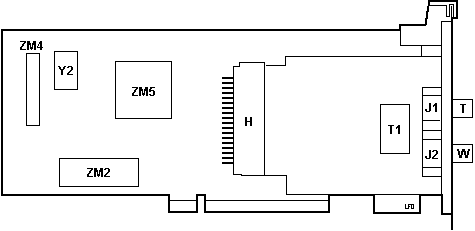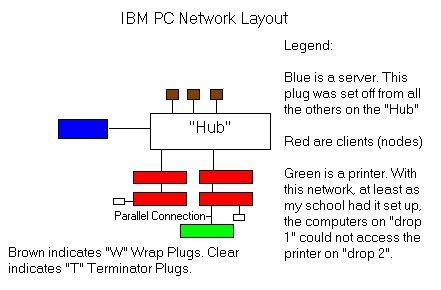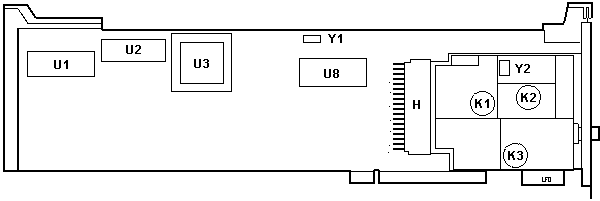|
@EFEF.ADF IBM PC Network Adapter (Both Baseband and Broadband)
187-082 IBM PC Network Baseband Adapter/A (Wrap Plugs)
187-080 IBM PC Network Adapter II/A (Coax)
187-219 IBM PC Network Adapter II/A-Frequency 2 and 3 (Coax)
PC Network Baseband Adapter
PC Network Broadband Adapter
Known Problems
ADF Sections
PC Network Baseband Adapter

H 36 position edgecard socket
J1 RJ11 Terminator
J2 RJ11 Wrap
T1 PE-64570
T Terminator Plug
|
W Wrap Plug
Y2 16.00000 MHz osc
ZM2 M5M5179P-45 RPL
ZM4 25F8241
ZM5 74F7673
|
PC Network Baseband Network Layout (from William R. Walsh)

It is a "baseband" adapter, whatever that means. Standard RJ11 phone cable
and connectors were used to connect the adapters together, and to a "hub" of
sorts. The adapters were not only attached to each other (a bus
topology), but each "bus" was connected at a central hub, creating a series of
connected "subnetworks" at the point of the hub.
As for the purpose of T and W plugs, W is identified as being a "Wrap Plug"
in my manual, and "T" as a terminator plug. The T plugs were plugged into the
second jack of the last adapter on a "line". If you took the "T" plug out of
the adapter, the whole line of computers failed to work (like a string of XMAS
lights), but other computers on other "subnetworks" would still work. As for
the "W" plug, it was put into any of the unused ports on the hub. If it was
taken out, the hub would fail to work at all. Also, the hub did not allow
communication between clients on two (or more) different "subnetworks" attached
to it. This made it necessary to have at least one computer that had a printer
on each "subnetwork". The server (if any was used) went into its own special
port on the "hub" that could communicate with any of the other connected
"subnetworks".
As for the insides of the "T" and "W" plugs, it looks like there is some
kind of resistor in the "T" (clear) plug. The "W" plug has something in it, but
I don't know what it is. Too dark brown to tell for sure.
The Baseband adapter supports daisy chain as well as star topologies via the
IBM 5173 PC Network Baseband Extender announced today in IBM Product
Announcement 187-083. Up to eight workstations can be linked together in a
chain topology with an overall length of up to 200 feet of 4-wire twisted pair
IBM Cabling System Type 3 specification telephone wire. A chain of workstations
linked to the 5173 can have an overall length of up to 400 feet. Up to ten
daisy chains with eight workstations each can connect to the Baseband Extender
for a maximum of 80 workstations in the baseband IBM PC Network.
Serial Connection of Baseband Adapters
"W" plug -- Machine 1 -- "T port" -- "W" port -- Machine 2 -- "T" plug.
If using a 5173, the T plug should be on the card farthest from the 5173. The W
plug should be in either one of the 5173's OUT ports.
Think of it like terminating a SCSI chain. Up to eight systems can be
serially connected.
Maximum Distance from First to Last Nodes
# Nodes Max Distance
2 91.4m (300 ft)
3 83.8m (276 ft)
4 76.0m (250 ft)
5 or 6 68.5m (225 ft)
7 or 8 61.0m (200 ft)
IBM PC Network Broadband
IBM's broadband PC Network addresses the specialized requirements of
customers who are combining their LAN with other services, such as video,
voice, security and/or additional data channels on a common broadband medium.
It may also be used to meet the requirements of small businesses and individual
work groups.
IBM PC NETWORK ADAPTER II: The IBM PC Network Adapter II is a feature card
for connecting the new IBM Personal System/2 Model 30 and IBM Personal
Computers to the broadband IBM PC Network. It is compatible with the form
factor and bus design of the original Personal Computer, yet it is designed to
take advantage of greater Intel 80286 and 8086 processing speeds.
The IBM PC Network Adapter II supports the NETBIOS interface and the
802.2/Logical Link Control (LLC) protocols via the IBM LAN Support Program
which was also announced today. This allows the adapter to provide access to
IBM PC Network and IBM Token-Ring Network applications written to the NETBIOS
or APPC/PC interfaces.
The IBM PC Network Adapter II is also compatible with the protocols of the
original PC Network Adapter via the IBM PC Network Protocol Driver program
which was also announced today. This allows the adapter to take advantage of
the same protocol and interface as the original IBM PC Network. See IBM Product
Announcement 187-079, dated April 2, 1987, for details.
IBM PC Network Adapter II/A
The IBM PC Network Adapter II /A is a feature card specifically designed for
connecting the new IBM Personal System/2 Model 50, Model 60, Model 80-041, and
Model 80-071 computers to the broadband IBM PC Network. It is compatible with
the form factor and bus design of these new Personal System/2s to take
advantage of greater Intel 80286 and 80386 processing speeds.
The IBM PC Network Adapter II/A supports the NETBIOS interface and the
802.2/LLC protocols via the IBM LAN Support Program which was also announced
today. This allows the adapter to provide access to IBM PC Network and IBM
Token-Ring Network applications written to the NETBIOS or APPC/PC
interfaces.
The IBM PC Network Adapter II/A is also compatible with the protocols of the
original IBM PC Network Adapter via the IBM PC Network Protocol Driver program
which was also announced today. This allows the adapter to take advantage of
the same protocol and interface as the original IBM PC Network.
The IBM PC Network Adapter II/A is not designed for use in the IBM Personal
System/2 Model 30. See IBM Product Announcement 187-080, dated April 2, 1987,
for details.
Channel usage, frequencies, offsets, and splits
| Adapter |
TX Channel |
RX Channel |
Offset |
Split |
| PC Ntwk Adt,II, II/A |
T14 (47.75-53.75) |
J (216-222) |
168.25 |
Mid Only |
| PC Ntwk Adt II/A -Freq 2 |
2' (53.75-59.75) |
O (246-252) |
192.25 |
Mid/High |
| PC Ntwk Adt II/A -Freq 3 |
3' (59.75-65.75) |
P (252-258) |
192.25 |
Mid/High |
PC Network Broadband Adapter

H 36 position edgecard socket
K1,2 Kyocera 39.5M L
K3 Kyocera 50MA
U1 Intel D82588
U2 Hitachi HM6264LP-12
|
U3 SLA6270J1B (62X0870)
U8 72X8139
Y1 16.0 NDK.8741 xtal
Y2 KXN 6321 xtal
|
I have a similar card that has the module used in the broadband adapter
above. Possibly this card/module combination could be used as a baseband or
broadband with the swapping of the module. The slot cover and module are
attached to the base card with two screws. To swap the module, you unscrew both
screws on the back of the base card and then screw on the new module after
plugging it in the socket.
Broadband Adapter Compatibility
Direct communication between PC Network adapters is possible only when each
adapter uses the same RF channels and the same protocols. The PC Network
Adapters (original, II, and II/A), the IBM PC NETWORK ADAPTER II/A - FREQUENCY
2 and the IBM PC NETWORK ADAPTER II/A - FREQUENCY 3 cannot communicate directly
with each other. For communication between different RF channel pairs, bridging
is required. Broadband PC Network adapters can communicate with each other
according to the table below:
| # | = Direct communication supported when both adapters
are using PC LAN Support Program (802.2 protocols).
| | = Bridging required for communication.
1 2 3 4 5 6 7
|---+---+---+---+---+---+---|
- IBM PC Network Adapter | # | # | # | | | | |
|---+---+---+---+---+---+---|
- IBM PC Network Adapter II | # | # | # | | | | |
|---+---+---+---+---+---+---|
- IBM PC Network Adapter II/A | # | # | # | | | | |
|---+---+---+---+---+---+---|
- IBM PC NETWORK | | | | | | | |
ADAPTER II - FREQUENCY 2 | | | | # | # | | |
|---------------------------|
- IBM PC NETWORK | | | | | | | |
ADAPTER II/A - FREQUENCY 2 | | | | # | # | | |
|---+---+---+---+---+---+---|
- IBM PC NETWORK | | | | | | | |
ADAPTER II - FREQUENCY 3 | | | | | | # | # |
|---+---+---+---+---+---+---|
- IBM PC NETWORK | | | | | | | |
ADAPTER II/A - FREQUENCY 3 | | | | | | # | # |
|---+---+---+---+---+---+---|
Note: Adapters that use unlike protocols can
coexist with each other on the same coaxial cable, but will not be able to
communicate with each other.
The 5178 IBM PC Network Translator Unit is not compatible with the
frequencies used by the IBM PC NETWORK ADAPTER II/A - FREQUENCY 2 and the IBM
PC NETWORK ADAPTER II/A - FREQUENCY 3. A vendor translator is required.
Known Problems
PS/2 Adapter Installation Restrictions 3270, Token Ring, Etc. (H005662)
AdapterId EFEF "PC Network Adapter "
Type, Memory Location, Interrupt Level
The three adapter types are: primary, alternate
and Remote Program Load (RPL). The three memory
locations are MEM 1, MEM 2, or MEM 3. When you
specify the interrupt levels for the adapter, if it is
primary or RPL, use INT 2 or INT 3. If it is
alternate, use INT 3.
<"Primary,
Mem 1, Int 2" (620-627, int 2, C800-CFFF)>,
"Mem 2, Int 2" (620-627, Int2, D000-D7FF), "Mem 3, Int
2" (620-627, Int2, D800-DFFF), "Mem 1, Int 3"
(620-627, Int3, C800-CFFF), "Mem 2, Int 3" (620-627,
Int3, D000-D7FF), "Mem 3, Int 3" (620-627, Int3,
D800-DFFF)
"Alternate, Mem 1, Int 3" (628-62F,
Int3, CE00-CFFF), "Mem 2, Int 3" (628-62F, Int3,
D600-D7FF), "Mem 3, Int 3" (628-62F, Int3, DE00-DFFF)
"RPL, Mem 1, Int 2" (620-627,
Int2, C800-CFFF), "Mem 2, Int 2" (620-627, Int2,
D000-D7FF), "Mem 3, Int 2" (620-627, Int2, D800-DFFF),
"Mem 1, Int 3" (620-627, Int3, C800-CFFF), "Mem 2, Int
3" (620-627, Int3, D000-D7FF), "Mem 3, Int 3" (620-627,
Int3, D800-DFFF)
|